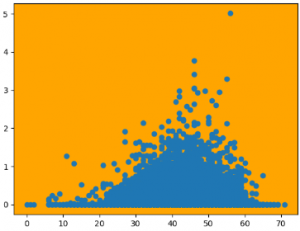

- SCATTER PLOT MATPLOTLIB FACECOLOR HOW TO
- SCATTER PLOT MATPLOTLIB FACECOLOR CODE
- SCATTER PLOT MATPLOTLIB FACECOLOR SERIES
- SCATTER PLOT MATPLOTLIB FACECOLOR FREE
SCATTER PLOT MATPLOTLIB FACECOLOR SERIES
However, since my actual data will consist of a variable number of arrays, with the actual number being unknown before runtime, I'm looking to plot each data series in the same scatter plot and with different colors, but without having to explicitly specify what colors to use. Then I do indeed see a series of data plots represented by unfilled red squares, but the downside is that I have to explicitly set what color I want using edgecolor. If I instead use plt.scatter(x, x**2, s=50, marker='s',facecolors='none',edgecolors='r') Which unfills the square markers, but does not leave any marker edges, so no output is actually seen. To that end, I tried using the following code: import matplotlib.pyplot as plt XyB=(30, 30), coordsB=plot3.I'm trying to produce a series of scatter plots with square and unfilled markers for each data point, with different but deterministic marker colors between runs, for each array. XyB=(20, 20), coordsB=ansData, color = 'red')įig.add_artist(conn2) #connecting line between the right corner of plot2 and the right #corner of the blue hightlightĬonn4 = ConnectionPatch(xyA = (30, 25), coordsA=ansData, Plot3.fill_between((25, 30), 10, 60, facecolor= "blue", alpha = 0.2) #connecting line between the rightcorner of plot1 and the right #corner of the red hightlightĬonn2 = ConnectionPatch(xyA = (20, 17), coordsA=ansData, t_ylim(25, 35) #highlighting the portion of original plot to zoon in Here is the complete code:įrom matplotlib.patches import ConnectionPatch

SCATTER PLOT MATPLOTLIB FACECOLOR CODE
Please check the comments in the code carefully for more clarity on the code. The portions to zoom will be highlighted with colors and the connecting lines will show clearly. There will be two small zoom-in windows on top and the original big plot at the bottom. This time I will use subplots to present the zoom_in window. Here is the complete code: from mpl_toolkits.axes_grid1.inset_locatorĪx.set_ylabel("Price") #Setting the limit of x and y direction to define which portion to zoom Please see the comments in the code below for some clear understanding. On the other hand, mark_inset function will draw the line from the original dots to the zoom window. The inset_axes function will define the size of the zoom window and the positioning of the zoom window. We need to import mark_inset and inset_axes functions first. I will use a length vs price plot this time.
SCATTER PLOT MATPLOTLIB FACECOLOR FREE
Please feel free to change those numbers and see what happens. The first two elements 0.2 and 0.7 define the positioning of the zoom window. Here the last two elements 0.2 and 0.2 mean the height and width of the zoom window.

The zoom window came from fig.add_axes() function that has one parameter inside.
SCATTER PLOT MATPLOTLIB FACECOLOR HOW TO
I am assuming you know how to do a scatter plot already. Look, a small zoom-out window inside the plot. Plt.title("Length vs Width and Color Represents the Changes of Price") Here is the complete code for that and I will explain it a bit after the plot: fig = plt.figure(figsize = (8, 6)) 'highway-mpg', 'price', 'city-L/100km', 'horsepower-binned', 'diesel', 'gas'],Īt first, I want to work on the zoom-out technique.įor that, I will make a scatter plot of the length vs width. 'bore', 'stroke', 'compression-ratio', 'horsepower', 'peak-rpm', 'city-mpg', 'height', 'curb-weight', 'engine-type', 'num-of-cylinders', 'engine-size', 'fuel-system',

'body-style', 'drive-wheels', 'engine-location', 'wheel-base', 'length', 'width', Output: Index(['symboling', 'normalized-losses', 'make', 'aspiration', 'num-of-doors', This is an open dataset that is mentioned here.


 0 kommentar(er)
0 kommentar(er)
